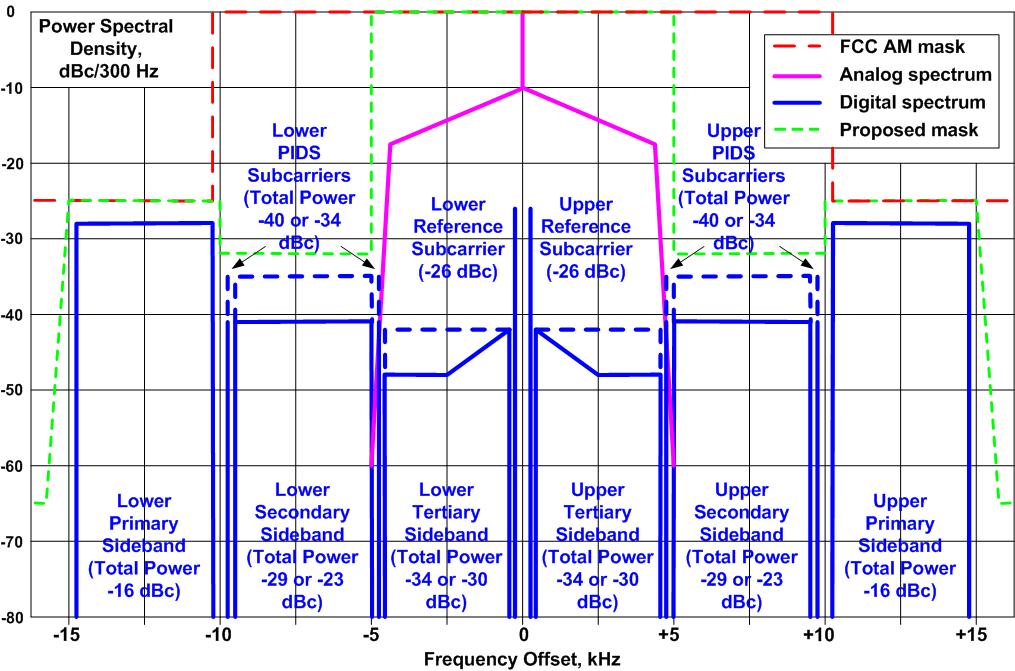| Parameter | Digital Sideband | Totals | ||||
| Primary | Secondary | Tertiary | PIDS [1] | Reference [2] | ||
| No. of subcarriers per sideband | 25 | 25 | 25 | 2 | 1 | 78 |
| Total subcarriers (both sidebands) | 50 | 50 | 50 | 4 | 2 | 156 |
| Frequency spacing from carrier, kHz | 10.36-14.72 | 5.09-9.45 | 0.36-4.72 | 4.91, 9.63 | 0.182 | |
| Modulation type (on each subcarrier of a given sideband)) | 64QAM | 16QAM | QPSK | 16QAM | BPSK | |
| Raw data rate, kb/s | 51.69 | 17.23 | 8.62 | 1.38 | 0.172 | 79.09 |
| Coding rate (ratio of information bits to total bits) | 5/12 | 2/3 | 2/3 | 1/3 | 1 | |
| Data rate after error correction coding, kb/s [3] | 21.54 | 11.49 | 5.74 | 0.46 | 0.172 | 39.40 |
| Actual information throughput, kb/s [4] | 20.19 | 16.15 | 0.43 | 0.091 | 36.86 | |
| Total power per sideband, dBc [5] | -16 | -29/-23 | -34/-30 | -40/-34 | -26 | -15.3/-14.7 |
| Total power per sideband for 50 kW station, Watts [5] | 1256 | 63/251 | 20/50 | 5/20 | 126 | 1470/1703 |
| Total power (both sidebands), dBc [5] | -13 | -26/-20 | -31/-27 | -37/-31 | -23 | -12.3/-11.7 |
| Total power (both sidebands) for 50 kW station, Watts [5] | 2512 | 126/502 | 40/100 | 10/40 | 252 | 2940/3406 |
| Notes | |
| [1] | PIDS = Primary IBOC Data Service, carrying station information, time of day, etc. |
| [2] | The reference subcarriers carry system control information such as mode and power level (see note [5]). |
| [3] | All lower/upper sideband pairs except for the primary sidebands are complex conjugates (mirror images) of each other and carry the same data, which cuts the overall data rate for each pair in half. This is done to minimize interference to an analog receiver tuned to the IBOC station. |
| [4] | This is the throughput available for the data payload after various housekeeping bits are accounted for. The primary sidebands carry the core mode (mono) audio stream. The data from the secondary and tertiary sidebands are combined to carry the enhanced mode stream, which provides stereo audio. |
| [5] | The IBOC specifications include a selectable power level control that allows setting the power of the secondary, tertiary and PIDS sidebands to two different levels. During the current interim operations, stations should be using the lower power level, so the first of the numbers in entries having two numbers should apply. Note that IBOC transmitters also allow independent control of the primary sideband power level, which can be used for mitigating adjacent channel interference, but this is not part of the IBOC specifications. Power expressed in dBc is relative to the AM carrier power. |

| Note: the IBOC specifications also include a mode that allows the analog signal bandwidth to extend to ±8 kHz instead of the usual ±5 kHz as shown above. There has never been any test data submitted for this mode, and I seriously doubt whether anyone will use it. There also has never been any test data submitted for the mode in which the power of many of the subcarriers is increased by 6 dB, as shown by the dashed lines in the digital spectrum plot. If the FCC permits it, many stations will no doubt use it, since it will increase the coverage for the enhanced (36 kb/s stereo) audio service. The downside is that will noticeably increase the noise level in most AM receivers tuned to the IBOC station. |